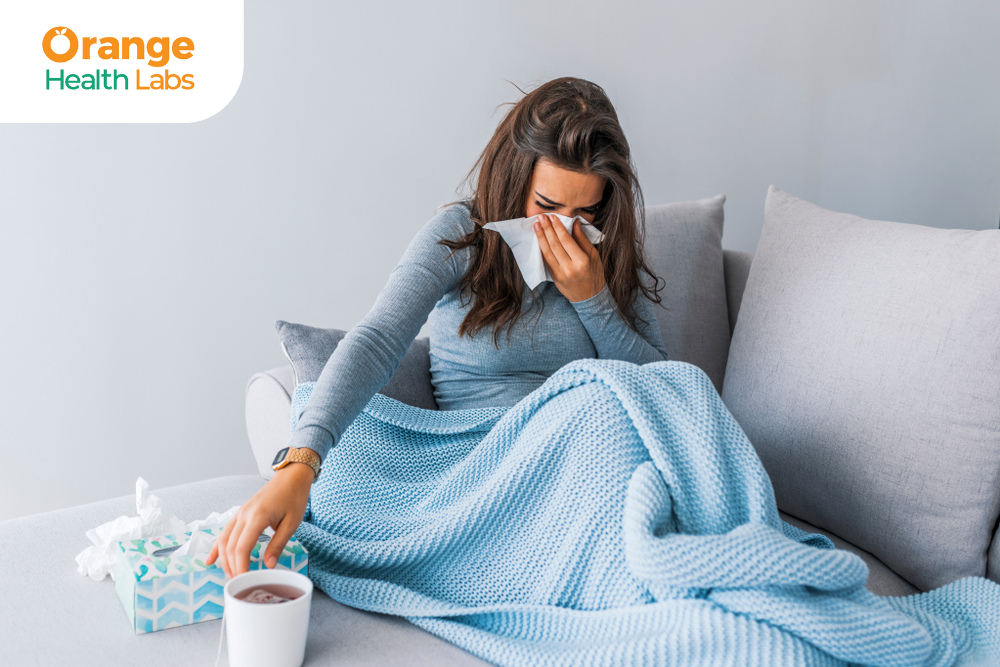Search for tests or checkups
SupportWhat Are Skin Allergy Types, Symptoms and Causes

Skin allergies, encompassing conditions like eczema, atopic dermatitis, and allergic contact dermatitis, are a growing concern worldwide. Studies suggest a significant global prevalence of skin allergies, with a concerning rise in low- and middle-income countries.
Environmental factors such as pollution, diet, and climate change are believed to play a significant role in the rise of skin allergies. Lifestyle factors play a role in the rising burden of skin allergies as well. For example, studies suggest a rise in skin allergies in the city of Mumbai, India, due to factors such as changes in climate and increased air pollution. Lifestyle factors such as smoking, alcohol, obesity, and poor sleep conditions also contribute to an increased risk of inflammatory skin conditions like atopic dermatitis and contact dermatitis.
Understanding environmental triggers and seeking proper medical advice are crucial steps in managing skin allergies and preventing complications. By raising awareness and implementing preventive measures, we can create a healthier environment and improve the quality of life of people with skin allergies.
Understanding Skin Allergies
Skin allergies, also known as cutaneous allergies, are a type of immune system response triggered by specific substances that come into contact with the skin or are inhaled and then deposited on the skin. Unlike other allergies that affect the respiratory system (hay fever) or cause digestive issues (food allergies), skin allergies manifest as reactions on the skin.
Upon first exposure to an allergen, the immune system identifies it as harmful and produces specific antibodies (proteins) designed to fight it. This initial exposure typically doesn't cause any symptoms. During subsequent exposures to the allergen, the immune system recognises it and activates the antibodies, which trigger the release of inflammatory chemicals, like histamine, in the body. The release of these chemicals leads to the hallmark symptoms of a skin allergy, such as redness, itching, swelling, and sometimes even blistering.
By understanding how the immune system reacts to allergens and the resulting skin manifestations, we can better identify and manage skin allergies, promoting greater comfort and well-being.
Types of Skin Allergies
Skin allergies come in various forms, each with its distinct characteristics. Let’s have a look at some of the most common types:
- Atopic Dermatitis or Eczema:
- Symptoms: This chronic condition often starts in early childhood and causes dry, itchy, and inflamed skin. It can manifest as red, scaly patches, bumps, or even weeping sores.
- Affected Areas: Eczema commonly affects the face, hands, inner elbows, and backs of the knees, but it can appear anywhere on the body.
- Urticaria or Hives:
- Symptoms: Hives are raised, itchy welts that appear suddenly on the skin. They can be red-, pink-, or skin-coloured and vary in size and shape. Unlike eczema, hives typically resolve within hours or days.
- Triggers: Hives can be triggered by allergens (food, medication, latex), infections, insect bites, or even stress and exercise.
- Allergic Contact Dermatitis:
- Causes: This itchy, red rash develops in reaction to direct contact with an allergen. Common culprits include nickel (in jewellery), fragrances (in cosmetics), poison ivy/oak/sumac, latex, and certain topical medications.
- Manifestations: The rash typically appears within 48 hours of exposure and develops at the contact site. Depending on the severity of the reaction, there can be mild redness or blistering.
- Angioedema:
- Symptoms: Similar to hives, angioedema causes swelling of deeper skin layers, affecting areas like the face, lips, tongue, eyelids, or genitals. This swelling can be painful and uncomfortable, sometimes even obstructing airways.
- Potential Complications: Angioedema can be a serious concern if it affects the airway, causing difficulty breathing. If you experience swelling in your throat or difficulty breathing, seek immediate medical attention.
- Hereditary Angioedema (HAE):
- Genetic Factors: HAE is a rare genetic disorder causing recurrent episodes of angioedema. Unlike allergic angioedema, HAE is not triggered by allergens but by a deficiency in a specific protein that regulates swelling.
- Symptoms: Similar to angioedema, HAE causes swelling of deeper skin layers, often affecting the face, abdomen, and airways. Triggers can be spontaneous or triggered by stress, injury, or certain medications.
If you experience any concerning skin symptoms, consult a healthcare provider for diagnosis and a personalised management plan.
Causes and Triggers of Skin Allergies
Skin allergies, often characterised by redness, itching, and inflammation, can erupt due to a complex interplay of internal and external factors. Let’s delve deeper and have a look at some common culprits:
- Metals like cobalt and nickel
- Synthetic fragrances in perfumes, cosmetics, soaps, and detergents
- Latex gloves, balloons, and other latex products
- Certain antibiotic creams or ointments
- Poison ivy, oak, and sumac
- Dust mites
- Pollen
- Insect bites, like those from mosquitoes or bees
- Formaldehyde in fabrics, preservatives in cosmetics, and harsh cleaning products
- Sunlight exposure
A family history of allergies, including skin allergies, eczema, or hay fever, increases your risk of developing skin allergies. While the exact mechanisms are still under research, genetics appear to play a role.
Allergy testing can pinpoint the substances causing your skin reactions.
Symptoms and Reactions
Skin allergies send out distinct signals through a variety of symptoms and reactions. Here's a breakdown of the tell-tale signs associated with different types of skin allergies to help you differentiate them:
- Atopic Dermatitis (Eczema):
- Dry, itchy skin
- Red, inflamed patches
- Cracked skin
- Thickened skin
- Urticaria (Hives):
- Raised, itchy welts
- Rapid onset and disappearance
- Variable size and shape of the hives
- Colour changes of skin
- Hereditary Angioedema:
- Painful swelling beneath the skin
- Nausea and vomiting
- Difficulty breathing
- Allergic Contact Dermatitis:
- Redness and swelling in the affected area
- Intense and constant itching
- Bumps and blisters
- Dryness and cracking of the skin
- Burning or stinging sensations
- Angioedema:
- Deeper swelling
- Sensation of tightness
- Potential difficulty breathing
Here’s a table to help you understand the key differences between atopic dermatitis, urticaria, and angioedema at a glance:
| Feature | Atopic Dermatitis (Eczema) | Urticaria (Hives) | Angioedema |
| Itch | Intense, chronic itching | Intense, sudden itching | Less prominent itching, skin may feel tight |
| Skin lesions | Dry, red, inflamed patches, bumps, or weeping sores | Raised, red, itchy welts (wheals) | Deep swelling of skin layers |
| Onset and Duration | Chronic condition with flares | Sudden onset, resolves within hours/days | Sudden onset, resolves within hours/days |
| Location | Often on the face, hands, inner elbows, backs of knees | Can appear anywhere on the body | Face, lips, tongue, eyelids, genitals |
| Potential complications | Skin infections from scratching | Anaphylaxis (rare) | Difficulty breathing (potentially life-threatening) |
Diagnosis
Skin allergies, although often uncomfortable, can be effectively managed with early diagnosis and proper treatment. By prioritising early diagnosis and opting for comprehensive allergy test packages or skin allergy packages, you can gain valuable insights into your allergies, allowing for better management and a significant improvement in your quality of life. Don't hesitate to seek professional help and take control of your skin health.
Benefits of comprehensive allergy testing:
- Identifying specific triggers
- More targeted treatment
- Reduced trial and error
- Peace of mind and improved mental well-being
Preventive Measures
Here are some practical tips you can implement at home to prevent flare-ups and keep your skin healthy:
- Choose fragrance-free laundry detergents, soaps, lotions, and cosmetics.
- Choose loose-fitting clothing to avoid irritation.
- No matter how cloudy the day is, use a broad-spectrum sunscreen with SPF 30 or higher every day.
- Use a fragrance-free cleanser and lukewarm water to wash your skin.
- Never rub or scrub your skin harshly, as this can irritate it, instead, dry your skin by patting it.
- Use a fragrance-free moisturiser appropriate for your skin type to improve barrier function and prevent dryness, a common trigger for skin allergies.
Dietary Recommendations:
While there isn't a one-size-fits-all approach for skin allergies related to food, identifying your food allergen is the first step towards preventing an allergic reaction. You can choose a comprehensive allergy panel to identify your allergen and eliminate it from your diet.
Nine major food allergens are known to commonly cause allergic reactions: Eggs, milk, peanuts, tree nuts, soybeans, wheat, sesame, shellfish, and fish. It is best to avoid these until you identify your specific allergen.
Based on your medical history, your doctor may also help you set up a diagnostic elimination diet plan in place, in which you can exclude a suspected food for 4-6 weeks. If you do not have an allergic reaction during this period, you may be allergic to this food. You may require a food challenge test to confirm the results of the elimination diet.
Here are some dietary tips to keep your skin healthy:
- Drink at least 8 glasses of water throughout the day to keep your skin hydrated.
- Eat colourful fruits and vegetables rich in vitamins, minerals, and antioxidants that support skin health.
- Include healthy fats from sources like avocado, olive oil, or fatty fish in your diet for skin nourishment.
- Consider incorporating probiotic-rich foods like yoghurt (if not dairy-allergic) or fermented foods like kimchi or sauerkraut to support gut health, which can indirectly impact skin health.
By following these tips and working with your healthcare provider, you can create a personalised plan to prevent skin allergies and maintain healthy skin.
Book a allergy test package in your city: Allergy Test Package in Noida | Allergy Test Package in Bangalore | Allergy Test Package in Mumbai | Allergy Test Package in Hyderabad | Allergy Test Package in Gurgaon | Allergy Test Package in Faridabad | Allergy Test Package in Delhi
Conclusion
Skin allergies, while frustrating at times, are manageable with the right approach. By implementing preventive measures and proper care, you can significantly reduce flare-ups and improve your overall quality of life. Keep a close eye on the skin and be proactive in managing your allergies. Develop a treatment plan tailored to your needs after consultation with your doctor. Embrace the journey, manage your allergies effectively, and live a fulfilling life!

CBC Test vs Other Blood Tests: Understanding the Differences

The Role of HIV Testing in Preventing the Spread of HIV
